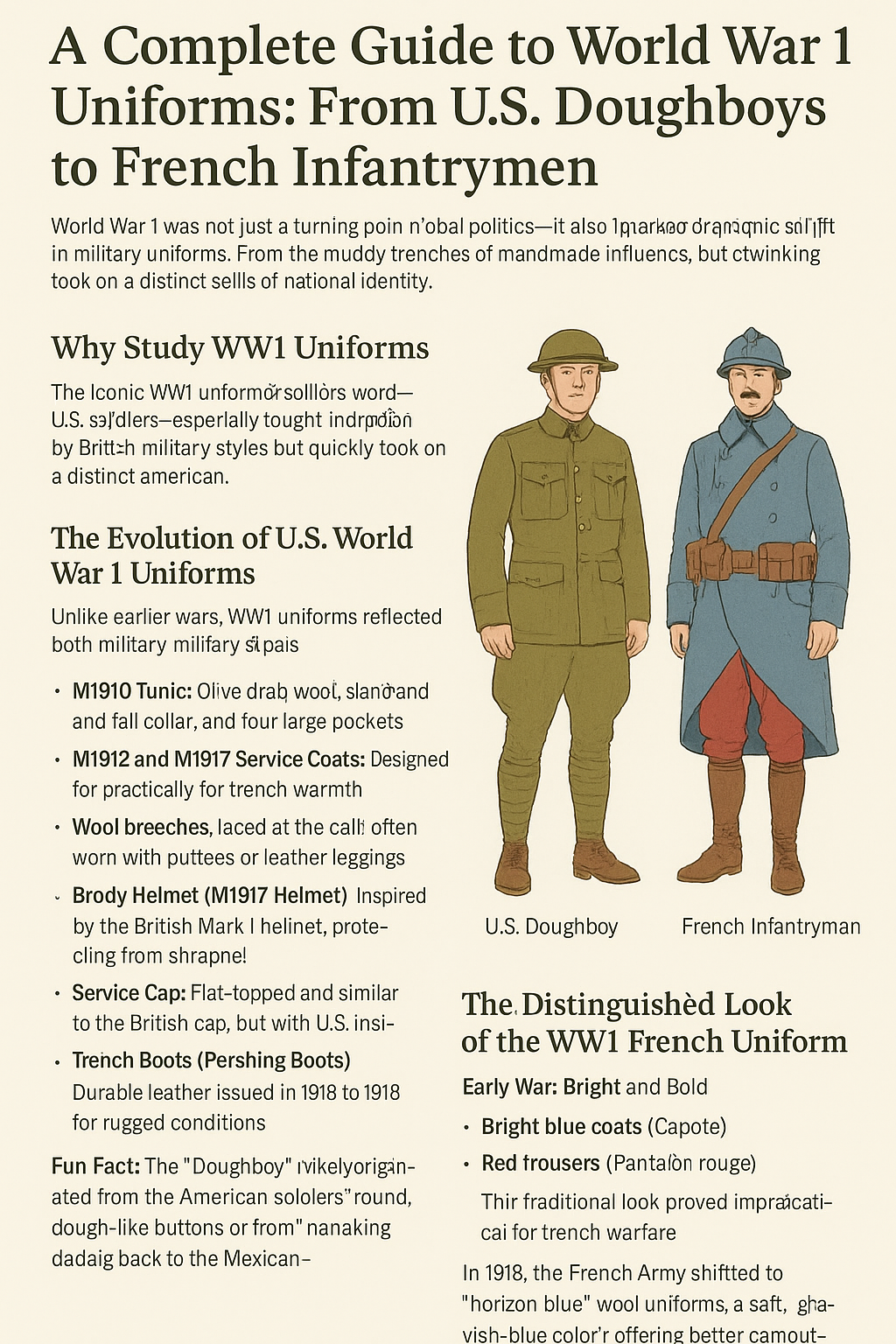
A Complete Guide to World War 1 Uniforms: From U.S. Doughboys to French Infantrymen
Published on Jul 21, 2025
A Complete Guide to World War 1 Uniforms: From U.S. Doughboys to French Infantrymen
World War 1 was not just a turning point in global politics—it also marked a dramatic shift in military uniforms. From the muddy trenches of the Western Front to the frontlines in France, uniforms became symbols of national identity, resilience, and functionality. This guide explores the most iconic WW1 uniforms, focusing on both World War 1 uniforms from the United States and the striking designs of the WW1 French uniform.
Whether you're a collector, reenactor, or just a military history enthusiast, understanding the details behind these uniforms helps bring the Great War’s legacy to life.
Why Study WW1 Uniforms?
The uniforms worn during WW1 offer a window into the era’s social, military, and technological transformations. Unlike earlier wars, WW1 uniforms reflected both tradition and innovation. They adapted to the demands of trench warfare, chemical attacks, and machine gun fire—all while maintaining national pride.
Uniforms were not just about aesthetics. They were functional tools of war, and each nation developed unique designs to suit its military doctrine and battlefield conditions.
The Evolution of U.S. World War 1 Uniforms
The Iconic Doughboy Uniform
The World War 1 uniforms United States soldiers wore—especially those of the famous "Doughboys"—are among the most recognized from the era. These uniforms were heavily influenced by British military styles but quickly took on a distinct American identity.
Key features:
- M1910 Tunic: Olive drab wool, stand-and-fall collar, and four large pockets.
- M1912 and M1917 Service Coats: Designed for practicality and warmth in the trenches.
- Breeches: Wool breeches laced at the calf, often worn with puttees or leather leggings.
- Brody Helmet (M1917 Helmet): Inspired by the British Mark I helmet, it protected soldiers from shrapnel.
- Service Cap: Flat-topped and similar to the British cap, but uniquely styled with U.S. insignia.
- Trench Boots (Pershing Boots): Durable leather boots issued in 1918 for rugged conditions.
Fun Fact: The nickname "Doughboy" likely originated from the American soldiers’ round, dough-like buttons or from slang dating back to the Mexican-American War.
Uniform Colors and Insignia
Olive drab was the standard color for U.S. uniforms. The practical tone provided basic camouflage in the muddy European landscape. Insignia varied based on division, rank, and role. Shoulder patches and brass collar disks identified infantry, engineers, medics, and more.
The Distinguished Look of the WW1 French Uniform
In contrast to the U.S. Army’s more muted palette, the WW1 French uniform evolved significantly over the course of the war.
Early War: Bright and Bold
At the beginning of the war, French soldiers wore:
- Bright blue coats (Capote)
- Red trousers (Pantalon rouge)
This traditional look reflected 19th-century military fashion but was highly visible and impractical for trench warfare.
Mid-War Shift to "Horizon Blue"
In 1915, the French Army made a dramatic change:
- Horizon Blue Wool Uniforms: The soft, grayish-blue color offered better camouflage while maintaining national identity.
- Adrian Helmet (introduced 1915): A revolutionary steel helmet featuring the French national crest, designed to protect against shrapnel.
- Puttees and Tall Leather Boots: Similar in function to U.S. gear but distinct in design.
Key Elements of the WW1 French Uniform:
- Double-breasted greatcoat
- Kepi or Adrian helmet
- Horizon blue tunic with stand-up collar
- High-waisted trousers or breeches
Uniforms of Other Major Powers (Quick Overview)
While this guide focuses on WW1 uniforms from the U.S. and France, it’s worth briefly mentioning other countries for context:
- British Army: Khaki service dress, Brody helmet, short tunics.
- German Empire: Feldgrau (field gray) tunics, Pickelhaube helmet early on, later replaced by the Stahlhelm.
- Austro-Hungarian Forces: Field-gray uniforms with unique rank insignia and traditional headwear like the shako.
Accessories and Gear: Completing the Look
Uniforms were more than coats and trousers. They included critical gear for survival and combat:
- Gas Masks: Essential by 1915 due to the use of mustard gas and chlorine gas.
- Ammunition Belts and Bandoliers: Carried cartridges, grenades, and personal items.
- Canteens and Mess Kits: Issued to all soldiers.
- Entrenching Tools: Compact shovels for digging trenches and fortifications.
- Field Packs and Bedrolls: Used to carry essential items like food, hygiene gear, and extra clothing.
WW1 Uniforms in Reenactment and Collecting
Today, authentic WW1 uniforms are highly sought after by collectors, historians, and reenactors. Whether you're participating in living history events or preserving family heritage, accurate reproduction gear is crucial.
Where to Find Authentic Uniforms
At Paddelaters.com, we specialize in detailed, historically accurate WW1 uniforms and accessories. Our collection includes:
- U.S. Doughboy tunics
- French Horizon Blue sets
- Reproduction helmets, boots, and gear
- Accessories like belts, bags, and insignia
We pride ourselves on providing military enthusiasts with quality reproductions based on original WW1 patterns.
Why WW1 Uniforms Still Matter
WW1 uniforms aren’t just relics of a century-old conflict. They’re a powerful way to connect with history, understand the human experience of war, and preserve stories that might otherwise be forgotten. From the mud-covered helmets of Verdun to the well-kept jackets of U.S. infantrymen, each piece tells a story.
Final Thoughts
Understanding the evolution of World War 1 uniforms, especially those worn by the United States and France, gives us a deeper appreciation of military history and heritage. Whether you're collecting, studying, or reenacting, every button and badge has meaning.
If you're looking to explore the past with unmatched accuracy, shop our full collection of WW1 uniforms and accessories at Paddelaters.com.
